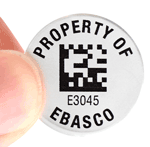Asset management in transition at the DoD
Asset management has come a long way since the days when a Corporal Klinger type could pick up the phone and finagle a turkey — or a tank — for his M*A*S*H unit. But have the military’s procedures come a long way with it?
Today, the Department of Defense must keep track of a mind-bending roster of spare parts, food, fuel and other vital supplies and equipment for its component branches at home and around the globe; by its own estimate, the department spent more than $171 billion on logistics and supply chain management in 2011 alone. In 2012, its Defense Transportation System moved about 8 million tons of cargo by air and surface; that tonnage was composed of 10 general classes of supplies, each encompassing many different items, according Cynthia Bauer, spokesperson for the department’s U.S. Transportation Command.
To make a long story short, the DoD It runs what is easily among the biggest and most complicated asset management operations in the world.
So, to paraphrase the late Mayor Koch, how’s it doin’?
According to the U.S. Government Accountability Office, it’s not doing as well as it could. A GAO report, “A Completed Comprehensive Strategy Is Needed to Guide DoD’s In-Transit Visibility Efforts,” was issued late last month, and it says, in a nutshell, that the DoD could do better because, among other things, there’s no centralized in-transit tracking function across the entire department.
“The Department of Defense (DoD) has taken steps to improve in-transit visibility of its assets through efforts developed by several of the Defense components, but no one DOD organization is fully aware of all such efforts across the department, because they are not centrally tracked,” the report elaborated.
 Incoming Secretary of Defense Chuck Hagel inherits a tangled web of asset management systems. Licensed under Creative Commons, via Secretary of Defense.
Incoming Secretary of Defense Chuck Hagel inherits a tangled web of asset management systems. Licensed under Creative Commons, via Secretary of Defense.
Not that this is anything new. In fact, it’s an issue that has been batted back and forth for more than 20 years. The Government Accountability Office, as part of its mandate to audit U.S. government operations, studies what it deems “high-risk areas.” The DoD’s supply chain management has been on the GAO’s high-risk list since 1990.
Zina D. Merritt, director of the GAO’s Defense Capabilities and Management division, said in an email interview that “DoD has had individual efforts under way to improve asset visibility. These efforts have been positive steps; however, GAO for many years has encouraged DoD to take a more integrated, comprehensive approach to overseeing and addressing problems across the department and implementing associated initiatives.”
The GAO’s report notes 34 separate in-transit visibility efforts that are carried out by the DoD’s varied component branches (the Army, the Navy, the Air Force, the Marines, as well as the Joint Staff, Central Command, Defense Logistics Agency and the U.S. Transportation Command). The DoD conducts “some informal information coordination and information sharing” the report notes, but not “through a formal mechanism.”
Specifically, said Merritt, the DoD needs to draft and implement a strategy to improve asset visibility. She also brought up the issue of IUID.
Some background: the DoD uses many kinds of asset tracking tools for the varied cargo it moves around. According to Bauer, its AIT (Automatic Identification Technologies) include active RFID technology (for Air Force pallets and large shipping containers); passive RFID (on a more limited basis for small parcels, where it can be embedded into shipping labels or applied separately); and shipping labels (which include both two-dimensional and linear barcode technology as well as information that can be read by humans and machines).
 Linear barcodes like these are still in use at the DoD – alongside a morass of passive and active RFID and other systems. Via myassettag.com.
Linear barcodes like these are still in use at the DoD – alongside a morass of passive and active RFID and other systems. Via myassettag.com.
It also uses satellite and cellular transponders in “austere environments or where enhanced visibility is required for critical or sensitive cargo” and Electronic Data Interchange on commercial cargo transports.
In addition, the U.S. Transportation Command has developed an “in-transit visibility system of record.” The Integrated Data Environment/Global Transportation Network Convergence, or IGC, is part of the Transportation Command’s effort to consolidate in-transit visibility data into a single enterprise database. Bauer noted that it’s the “corporate data repository for ITV information,” but it does not replace the need for the various other DOD business systems.
Since 2003, the department has also required most of its assets to be identified by IUID—Item Unique Identification. Under this system, assets are to be identified with a two-dimensional matrix mark, either tattooed onto the item with laser or chemical etching, inkjet or dot peen, or with a durable metal or polyester adhesive tag.
The matrix contains unique information that identifies the asset and remains unchanged for the life of the item, wherever it is deployed in the world and however it might be modified. The information is fed into a central IUID Registry. The idea, according to one of the DoD’s gazillion websites, is to have one big database that can offer total asset visibility, keep track of financial transactions, contracting, logistics, maintenance and engineering. Asset marking with IUID is a key component of the department’s overall logistics and supply chain management.
But according to Merritt, “With respect to IUID, DoD needs to, among other steps, take actions to improve management of IUID implementation.” She noted, too, that DoD should enable the various branches to report complete data for marking items with IUID labels, and to share data across the DoD enterprise information systems.
Would that get the DoD off the high-risk list? Well, not exactly.
Merritt explained that the GAO has a five-point checklist of things that the DoD needs to do first. It has already aced the first two—demonstrating commitment to address the problem and having the capacity to do so. (Commitment? Capacity? The GAO report notes that the DoD obligated about $701 million to this issue for the years 2009 – 2011 and has projected spending another $455.3 million by 2015.)
But the GAO’s other three criteria remain yet unmet, Merritt said: the DoD has started but not completed a department-wide corrective action plan. It has yet to implement the plan or devise a program to monitor it.
This particular GAO report zeroes in on in-transit visibility, but notes that previous reports have focused on the challenges the DoD faces in instituting new asset tracking technology and the lack of “interoperability” among IT systems. The result of all these challenges? The GAO report notes that in 2011, it came up with a laundry list, including: unmet delivery standards and time lines for cargo shipments; incomplete delivery data for many surface shipments; inadequate RFID information to track cargo movements to and within Afghanistan; no means to integrate the DoD’s many transportation information systems; difficulties in tracking information on pilferage and damage; and ineffective management of cargo containers.
The DoD says that its Asset Visibility and In-Transit Visibility Strategy document will be finalized by June of this year.
Asked what it would take to upgrade asset visibility and in-transit visibility, Bauer noted that the plan would be the first step: “When completed, the DoD strategy document for improving asset and in-transit visibility will specifically address the supply chain weaknesses the GAO highlighted. The document and its supporting execution plans will assist and guide DoD components in their continued effort to improve asset and in-transit visibility.”
But will the plan stay on track? Well, there’s the little matter of across-the board budget cuts that will come from the Congressionally mandated sequestration. That sounds like it could gum up the works. Merritt declined to comment on this possibility, saying that the GAO hasn’t reviewed the issue, but Bauer said firmly that the “document is a long-term strategy and contains numerous supporting execution plans which will take years to complete. At this time, we do not expect sequestration to affect this timeline.”
Corporal Klinger, where are you when we need you?
Category: Barcodes and RFID















